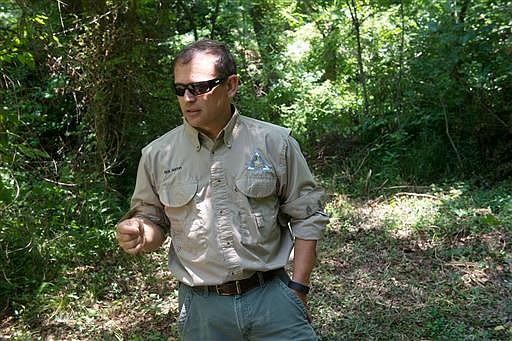SARCOXIE, Mo. (AP) - In the late 19th century, Ruth Hoppin squeezed herself through a tiny opening in the middle of a cave in this Southwest Missouri town and collected samples of a small, translucent fish, painstakingly observing it for days.
It was the first recorded specimen of what is now known as the Ozark cavefish.
Hoppin, the fish's discoverer, was praised in her day for her work but has now largely been forgotten.
The Joplin Globe (http://bit.ly/28MYuu4 ) reports that she was a teacher at heart and spent much of her time studying biology and making discoveries, many of which were in her native Michigan. But Missouri biologists mainly credit her for the discovery of the Ozark cavefish, as well as a blind crayfish in the Sarcoxie cave and a nearby well.
"She did a lot of things women from her time didn't do," said Mary Snow, Hoppin's great-great-niece who lives in Three Rivers, Michigan.
Hoppin as a teacher
Hoppin, born in New York in 1833, always knew she wanted to be a teacher because she had a passion for both teaching and learning.
"Much of the time till I was 15 years of age, my only schooling was obtained by walking two miles and a quarter through the dust of Prairie Ronde in the summer and its drifting snows in the winter," she recalled in a letter written later in her life.
In 1849, Hoppin began her teaching career at a Michigan school and continued her education at Oberlin College, the completion of which took seven years. In order to pay for her education, she sometimes was forced to take absences from school so that she could work.
"In those days, self-education required both energy and will, and I fought the battle nearly alone," she later wrote about her decision to attend college.
She taught botany, literature and history at schools in Three Rivers and Ypsilanti, Michigan, before becoming a teacher of psychology, biology and botany at Smith College in Northampton, Massachusetts.
"With a most wonderful memory, she was an authority on all historical subjects, but her rare talent lay in scientific research in botany and biology," biographer Eliza Trump Reed wrote in 1903.
In 1890, Hoppin returned to the University of Michigan to pursue literary studies and received her master's degree the following year. Shortly thereafter, she retired due to her failing vision and moved back to Three Rivers, where she died in 1903.
The elementary school in that community was renamed Ruth Hoppin Elementary School in 1912 after a dozen teachers created a petition supporting the motion.
"She was a fascinating woman," Snow said. "I've been a teacher for 30 years, and I've always felt like she was my mentor."
The cavefish
In the 1880s, Hoppin traveled to Missouri during a lengthy sabbatical in order to recover from health issues, and it was here that she discovered the Ozark cavefish.
Listed federally as a threatened species since 1984, the cavefish is about as long as a pinkie finger and is so pale that it's nearly translucent. Because it lives only in the darkness of caves, it has no need for eyesight and is completely blind.
The fish therefore has a heightened sense of touch, experts say.
"They are very sensitive to vibrations in the water, and so in some ways, that makes up for their inability to see," said Doug Novinger, aquatic systems and biometrics unit supervisor at the Missouri Department of Conservation.
Novinger said everyone should be interested in the preservation of the cavefish because its presence in waterways is an indicator of clean water. Threats to the species include water pollution, changing water tables, declining bat populations, and cave disturbance and destruction.
And there is still more to learn. The Ozark cavefish has fewer fins than normal fish, and that could be a sign that they are well-adapted to their environment, said Rick Horton, fisheries management biologist at the Missouri Department of Conservation.
"They are interesting, but we don't know a whole lot about them because we don't have a chance to study them a whole lot," he said.
The Sarcoxie cave
The mound of rock on the edge of the Sarcoxie Spring is one of the homes to the Ozark cavefish. The cave is about 50 feet in circumference and is covered with vegetation. The Ozark Regional Land Trust bought the land in 1999 to preserve the space.
The trust and the city of Sarcoxie are currently working on a project that will repair a bridge that leads to the cave and will create a trail there.
"It's a beautiful place, and with a little bit of public management, I think the public will enjoy it," said Peggy Horner, executive director of the Ozark Regional Land Trust.
The cave entrance is sealed by a gate because entering the cave would disturb the fish, but the area around it is open to the public, Horner said.
"We want people to enjoy the cave, but not right around the entrance," she said.
___
Information from: The Joplin (Mo.) Globe, http://www.joplinglobe.com

